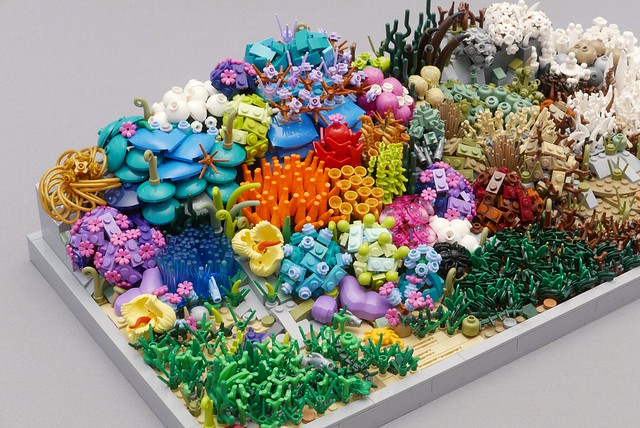Across the world’s oceans, tiny changes in the water temperature have massive effects on the organisms living there, especially the tiniest. Coral reefs, in particular, show in spectacularly tragic fashion the impact of rising ocean temperatures. When the water gets too warm, the algae that live symbiotically within the cells of coral polyps get expelled violently from the little animals. Though the coral polyps are still alive, they are no longer colorful and bright; they are left a cold, dull white, deprived of the photosynthesis-derived energy from the algae and fully dependent on catching little bits of passing debris in their tentacles. Slowly but surely, the vibrant and rich ecosystem that once thrived around the rocky haven of the coral reef dies away, leaving nothing but coral skeletons. Builder Emil Lidé brings this oceanic phenomenon to life in LEGO form beautifully yet tragically.
Emil presents to us the reef on the one hand in full splendor, with diverse forms of coral and plant life along with little fish hiding in the crevices, wandering crustaceans, and starfish; and on the other hand, the reef bleached white, with skeleton arms appropriately front and center, with no animals or plants still living there. This build will be spending the next year at the LEGO House in Billund, if you can make the trip.
In a build like this, there are too many clever piece usages to highlight them all, but I’ll call attention to the ones I find most remarkable. First off, there seems to be a whole band there, as I see a collection of trumpets, saxophones, and electric guitars arranged together. Then there is the minifigure hair, used creatively as well. I count at least four types of hair, the most interesting of which is the pink rockstar cut. There are pearl gold whips, carrots, spiders, and even the limbs and hands of a certain purple villain named after the Greek word for death (Coincidence? Did he ‘snap’ the coral, too?). Then, of course, there are countless flowers and dishes and bowls of various sizes and styles. The most remarkable thing about the build, I think, besides the message, is the way that Emil has arranged all of these various parts into a cohesive whole. Every delicate piece is in its proper place, just as in a fragile-yet-functioning ecosystem.
All hope is not utterly lost, however. While many of the world’s most prestigious reefs have suffered massive bleaching, including the Great Barrier Reef off Australia, which has suffered from bleaching events recently that affected up to 90% of the reef, some new corals are growing up and reaching sexual maturity, which can replenish the reefs and keep them flourishing. If something can be done to arrest the rise in ocean temperature, then we can continue to enjoy the beauty of the left side of the build. But if temperatures keep rising? It will look more like the right. So perhaps skip the trip to Billund to save the greenhouse gasses of the flight. Do what you can to save the reefs!


